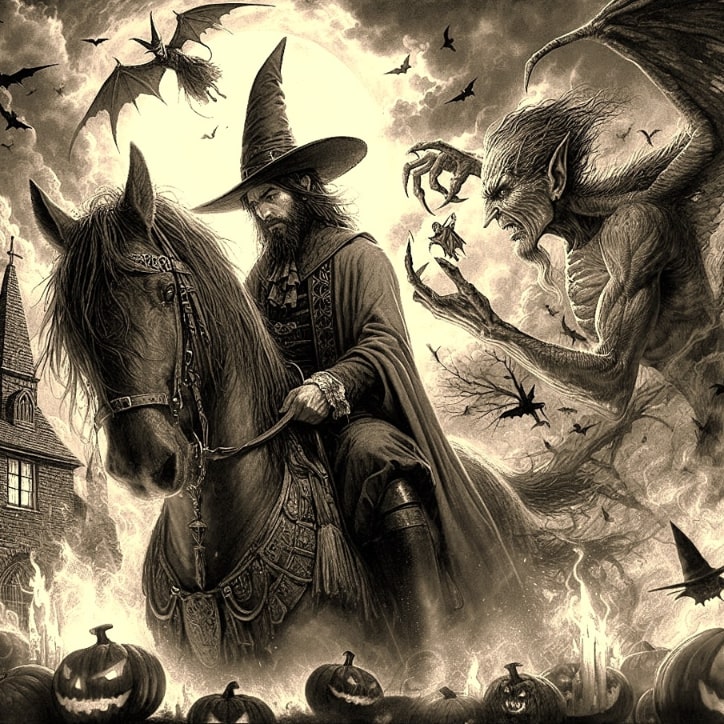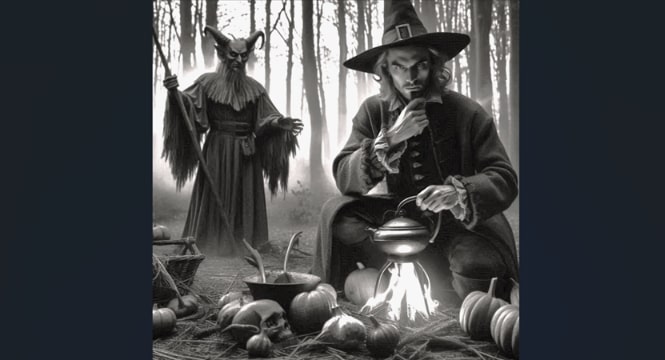Introduction: In this article, with Halloween approaching, Melissa Davenport Berry writes about an accused “warlock” in Newbury in 1679, 13 years before the Salem witch trials. Melissa is a genealogist who has a website, americana-archives.com, and a Facebook group, New England Family Genealogy and History.
Old Newbury, Massachusetts, had its share of spectral sensation way before the infamous Salem witch trials of 1692. Court records reveal the home of Elizabeth “Goody” Morse was the scene of an evil presence. Another case involved a herdsman shacking up on what is now the Spencer-Peirce-Little Farm who had “familiarity with the devil,” bewitching the entire countryside including its cattle and citizens.
To recap: My first story related the witchcraft cases of the Morse home.
Now for my second story: the witchy drama of a naughty knave who coasted into Massachusetts Bay Colony weaving an abominable web that no one could untangle. John Godfrey, the “Wicked Warlock of Essex County,” supposedly accompanied by an evil spirit and instigated by the devil, made much hurt and mischief by several acts of witchcraft to the bodies and goods of several persons. (Boston Court Records, 6 March 1665)

Not to mention the several lots of land Godfrey acquired all over the county – and no doubt sold or leased to one of your ancestors. This alone is why he should be studied, but perhaps his singleton, transient status has him overlooked.
If truth be told, Godfrey was no more of a black arts magnus than Elizabeth Morse was a witch, but Essex County residents wanted him to get the rope.
There are a few very informative works (in addition to Records and Files of the Quarterly Courts of Essex County, edited by George Francis Dow) that detail Godfrey’s drama.
The first is Witch-Hunting in Seventeenth-Century New England: A Documentary History 1638-1693, written by David D. Hall (2005). The second is by Professor John Putnam Demos entitled John Godfrey and His Neighbors: Witchcraft and the Social Web in Colonial Massachusetts, published in the William and Mary Quarterly, Vol. 33, No. 2 (April 1976).
And I came across this book review published in 1983 for Professor Demos’ work Entertaining Satan: Witchcraft and the Culture of Early New England that references Godfrey as an individual singled out by the community for witchery predating the 1692 Salem witchcraft hysteria.
Demos uses Freuden psychology to look at cases like Godfrey’s, where the attacks come from victims who strongly disliked him due to his personality characteristics, most of which were despicable.
According to sources, Godfrey arrived in 1634 on the ship Mary and John with John Spencer. He later worked herding cattle and sheep on John Spencer’s farm, who had become a leading man in the early settlement of Newbury. But then Spencer locked horns with the local Puritan posse and returned to England, leaving the farm to his nephew, also named John Spencer. Godfrey stayed on the Spencer farm and mastered a position as local herdsman. However, his deviant lifestyle was more wolf than shepherd.
Godfrey’s plebian nature (cursing, drunkenness, arson, tobacco smoking, assault, traveling on Sabbath, slander) was constantly landing him in front of the magistrates, who administered heavy fines and public humiliation.
For example, the court records in April 1669 report one sentence given to John Godfrey.
His crime:
“wicked and most pernicious subborning [sic] of witnesses to the perverting of justice both by himself and others, sometimes by hindering persons from giving evidence and sometimes instigating some to give false evidence.”
His sentence:
“was sentenced for these horrible and destructive crimes to pay 100li. fine and to stand upon the pillory one hour, with this inscription written in capital letters upon a paper fastened upon him: JOHN GODFREY, FOR SUBBORNING WITTNESSES.”
Many of these cases involved property. Godfrey had a side profession selling and deeding properties. I discovered that my ancestors Edward and Elizabeth (Adams) Phelps bought land from Godfrey in Andover, Massachusetts.
Godfrey’s methods for collecting property payments were anything but orthodox (see links to court records below). In fact, he filed 100+ lawsuits and countersuits over property, goods and services.
He won more than he lost, ticking off the community and earning a reputation as a bullying loan shark. Fed up with “the devilish rogue,” the town folk cried witchery on him.
The Spencer farm was the subject of one of his witch accusations. One testimony came from William Osgood, a carpenter who was hired by Spencer to build a barn. Osgood testified that Godrey told him he had a new master after making a covenant with the devil – but then Godfrey said he was only “teasing.”
Years after that exchange, Osgood bought land from Godfrey. The transaction was not harmonious. After 20 years of bad blood between Osgood and Godfrey, with several of his relatives and friends also getting the screws from Godfrey, they all came together to testify in a series of court appearances.
In one case Godfrey sued Jonathan Singletary (Dunham) for slander for calling him a witch. Additionally, there were other issues Godrey had with the fellow over debts owed to him, and Singletary was jailed in Ipswich, Massachusetts.
While in jail Singletary claimed Godfrey magically unbolted the locks and appeared to him. That was after many large cats climbed the walls (court records 4 March 1662). John Remington affirmed Singletary’s story.
Godfrey became an infamous “perennial witchcraft suspect,” often found “suspiciously guilty” but not “legally guilty” and was released with verbal warnings to discontinue his “blasphemous” way of life. He always returned to the nest of his accusers and almost immediately resorted back into his cheeky lifestyle, and no one got free from his tyrannical web. One time he was sent to the gallows and was sentenced to stand with a halter about his neck followed with a whipping, but that was for setting fire to a home he had tried to foreclose on.
A Few Cases from the Godfrey Court Files:
- Godfrey v. Richard Kent: for slander.
- Pike v. John Godrey: for taking a horse (and other goods) and storing them in Amesbury, Massachusetts, at Mrs. Cutt’s for debt owed by Edward Cottle.
- Godfrey v. William Simonds (and son Samuel): for slander calling him a witch.
Explore over 330 years of newspapers and historical records in GenealogyBank. Discover your family story! Start a 7-Day Free Trial
Note on the header image: the “wicked warlock” John Godfrey with the devil. Credit: Melissa Davenport Berry.
Related Articles:
- The Devil Went Down to Newbury (part 1)
- How the Accused Were Pinned for Witchcraft in Salem 1692
- Relics of the Salem Witch Trials Era (part 1)
- Relics of the Salem Witch Trials Era (part 2)
- Relics of the Salem Witch Trials Era (part 3)
- Relics of the Salem Witch Trials Era (part 4)
- Relics of the Salem Witch Trials Era (part 5)
